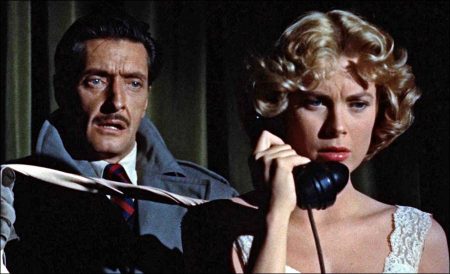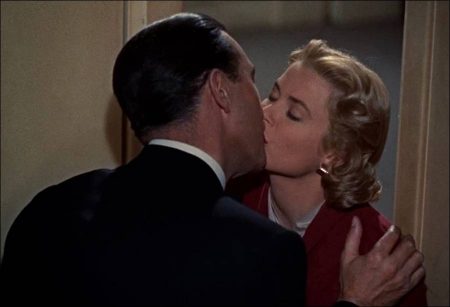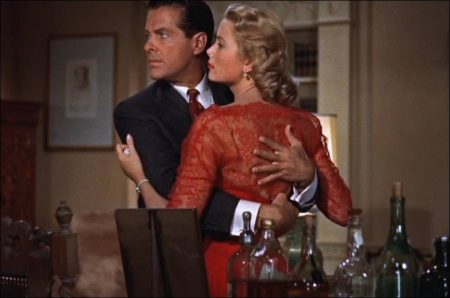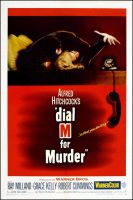Taglines: Kiss By kiss… Supreme suspense unfurls!
Dial M for Murder movie storyline. In London, wealthy Margot Mary Wendice had a brief love affair with the American writer Mark Halliday while her husband and professional tennis player Tony Wendice was on a tennis tour. Tony quits playing to dedicate to his wife and finds a regular job. She decides to give him a second chance for their marriage. When Mark arrives from America to visit the couple, Margot tells him that she had destroyed all his letters but one that was stolen.
Subsequently she was blackmailed, but she had never retrieved the stolen letter. Tony arrives home, claims that he needs to work and asks Margot to go with Mark to the theater. Meanwhile Tony calls Captain Lesgate (aka Charles Alexander Swann who studied with him at college) and blackmails him to murder his wife, so that he can inherit her fortune. But there is no perfect crime, and things do not work as planned.
Dial M for Murder is a 1954 American crime mystery film directed by Alfred Hitchcock, starring Ray Milland, Grace Kelly, Robert Cummings, and John Williams. Both the screenplay and the successful stage play on which it was based were written by English playwright Frederick Knott. The play premiered in 1952 on BBC Television, before being performed on stage in the same year in London’s West End in June, and then New York’s Broadway in October.
Originally intended to be shown in dual-strip polarized 3D, the film played in most theatres in ordinary 2D due to the loss of interest in the 3D process (the projection of which was difficult and error-prone) by the time of its release. The film earned an estimated $2.7 million in North American box office sales in 1954.
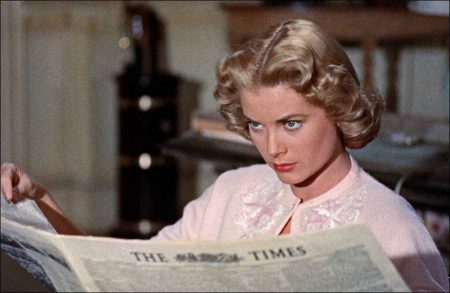
About the Story
Tony Wendice (Ray Milland), an English professional tennis player, is married to wealthy socialite Margot Wendice (Grace Kelly), who has had an affair with American crime-fiction writer Mark Halliday (Robert Cummings). When Tony retires from tennis, he secretly discovers the affair and decides to murder his unfaithful wife, both for revenge and to ensure that her money will continue to fund his comfortable lifestyle.
Tony invites an old acquaintance from the University of Cambridge, Charles Alexander Swann (Anthony Dawson), to his London flat. Tony is aware that Swann has become a small-time criminal with several aliases, and has been secretly following Swann so he can blackmail him into murdering Margot. Tony tells Swann about Margot’s affair. Six months ago, Tony had stolen her handbag, which contained a love letter from Mark, and anonymously blackmailed her. After tricking Swann into leaving his fingerprints on the letter, Tony offers to pay him £1,000 to kill Margot; if Swann refuses, Tony will turn him in to the police as Margot’s blackmailer. Swann’s credibility, in denying Tony’s accusation, would be hurt by his criminal record.
After Swann agrees, Tony explains his plan: the following evening he will go with Mark to a party, leaving Margot at home while hiding her latchkey outside the carpet of the staircase facing the front door of their flat. Swann is to sneak in when Margot is fast asleep and hide behind the curtains in front of the French doors to the garden. At eleven o’clock, Tony will telephone the flat from the party. Swann must strangle Margot when she answers the phone, open the French doors, leave signs that would trick the police into believing that a burglary had gone wrong, and then exit through the front door before hiding the key under the stair carpet again.
The following night, Swann enters the flat while Margot is in bed, and waits. At the party, Tony discovers that his watch has stopped, so he phones the flat three minutes later than intended. When Margot comes to the phone, Swann tries to strangle her with his scarf, but she manages to grab a pair of scissors and stab him fatally in the back. She picks up the telephone receiver and pleads for help. Tony tells her not to touch anything until he arrives home. When he returns to the flat, he calls the police and sends Margot to bed. Before the police arrive, Tony moves what he thinks is Margot’s latchkey from Swann’s pocket into her handbag, plants Mark’s letter on Swann, and destroys Swann’s scarf, replacing it with Margot’s own stocking in an attempt to incriminate her.
The following day, Tony persuades Margot to hide the fact that he told her not to call the police immediately. Chief Inspector Hubbard (John Williams) arrives and questions the Wendices, and Margot makes several conflicting statements. When Hubbard says Swann must have entered through the front door, Tony falsely claims to have seen Swann at the time Margot’s handbag was stolen, and suggests that Swann made a copy of her key. Hubbard does not believe this because no key was found on Swann’s body upon inspection. Hubbard arrests Margot after concluding that she killed Swann for blackmailing her. Margot is found guilty of murder and sentenced to death.
Some months later, on the day before Margot’s scheduled execution, Mark visits Tony, saying he has devised a story for Tony to tell the police in order to save Margot from execution. To Tony’s consternation, Mark’s “story” is very close to what did actually happen: that Tony bribed Swann to murder Margot. Tony says the story is too unrealistic. Hubbard arrives unexpectedly, and Mark hides in the bedroom. Hubbard questions Tony about large sums of cash he has been spending, tricks him into revealing that his latchkey is in his raincoat, and inquires about Tony’s attaché case. Tony claims to have lost the case, but Mark, overhearing the conversation, finds it on the bed, full of banknotes.
Dial M for Murder (1954)
Directed by: Alfred Hitchcock
Starring: Ray Milland, Grace Kelly, Robert Cummings, John Williams, Patrick Allen, George Leigh, George Alderson, Robin Hughes, Anthony Dawson, Richard Bender, Robert Dobson, Bess Flowers, Michael Hadlow, Harold Miller
Screenplay by: Frederick Knott
Cinematography by: Robert Burks
Film Editing by: Rudi Fehr
Set Decoration by: George James Hopkins
Art Direction by: Edward Carrere
Music by: Dimitri Tiomkin
MPAA Rating: None.
Distributed by: Warner Bros. Pictures
Release Date: May 18, 1954 (Philadelphia), May 29, 1954 (United States)
Views: 591
